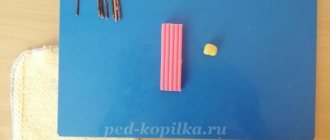Middle group. Junior preschool age. Children 4 - 5 years old
Minutes of the parent meeting of the middle group “We have become a year older” Agenda: 1. Summing up the educational work for the school year. 2. Familiarization with the work plan for the summer period. 3. Recommendations for organizing children's holidays in the family during the summer. On question I we heard: the teacher’s full name, who in her report on...
Minutes of the parent meeting in the second junior-middle group beginning of the year MINUTES No. 1 of the parent meeting in the second junior-middle group “Droplets”
dated September 10, 2021.
Present: 15 people Absent: 8 people Invited: head of MBDOU d/s No. 39 – Derdera M. N. Meeting : 1. Age-related features of the development of children from…
How are the minutes of the parent meeting drawn up?
During the meeting, it is necessary to draw up minutes - this is done by the secretary of the event. It can be any preschool teacher. The secretary can develop and use a pre-created minutes template and complete it during the meeting. Templates and samples of protocols for parent meetings in kindergarten are presented at the end of the article.
Minutes of preschool educational institutions meetings:
- record the progress of the meeting;
- provide a report to senior management on the implementation of assigned tasks;
- record existing orders;
- provide the opportunity to receive a report on the execution of tasks;
- help in resolving disputes.
The legislation does not oblige the use of certain frameworks for document execution. It can be drawn up on A4 paper and filled out manually or using a computer. The document header should contain:
- name of the preschool institution;
- theme of the meeting;
- date and location;
- number of participants.
The “Agenda” section should display the issues that will be discussed. They need to be formulated briefly.
The “Reports” section contains:
- a summary of the participants' speeches;
- questions from participants;
- answers to them.
At the end of the meeting, the minutes should contain all the information about the various issues discussed at the meeting, all the reports, as well as the solutions reached.
The minutes of the parent meeting in kindergarten must be certified by the chairman and secretary of the meeting. Sometimes the protocol is also signed by members of the parent committee. If the purpose of the meeting was to inform parents about something important (For example: a flu epidemic, the danger from ticks, etc.), you can draw up a “Familiarization Sheet.” It is signed by all those present and added to the minutes of the meeting as an appendix.
Decisions made during the meeting are binding on all children and parents, regardless of their presence at the meeting. If an important decision was made during the meeting, it is necessary to familiarize all parents with it (even those who were absent). To do this, you can call or place an ad in the “parents’ corner.”
Preview:
Municipal preschool educational budgetary institution
kindergarten No. 38
Municipal formation Korenovsky district
parent meetings in middle group "A"
for 2021 - 2021 academic year
Municipal preschool educational budgetary institution
kindergarten No. 38
Municipal formation Korenovsky district
parent meeting of secondary group No. 6 “Brusnichka” dated September 07, 2021.
Chairman: Sidorova K.V. - parent
Secretary: Manyuk E.A. - parent
There were 14 people present, the list is attached.
Topic: “Features of the educational process in the middle group”
1. Slideshow: “How we spent the summer.”
2. Preparation of information sheets: memos “Age characteristics of children in the fifth year of life”, schedule of activities, daily routine, rules for parents.
3. Development of a draft decision of the parent meeting.
I. Consultation on the topic: “Features of the educational process in the middle group.” Speaker: Ovdienko L.A.
II. Prevention of ARVI and influenza vaccination. Speech by teacher Ovdienko L.A.
III. Selection of the parent committee.
IV. The slide show “How We Spent the Summer” was prepared by L.A. Ovdienko.
I. On the first question: the teacher of the middle group Ovdienko L.A. spoke. She drew the attention of parents to the fact that the age from four to five years is a period of relative calm. The child came out of the crisis and generally became calmer, more obedient, and more flexible. The need for friends becomes more and more powerful, and interest in the world around us increases sharply.
She brought to the attention of parents that at this age the child actively manifests:
• Striving for independence. It is important for a child to do a lot on his own; he is now more able to take care of himself and needs less adult care. The other side of independence is a statement of one’s rights, needs, attempts to establish one’s own rules in the world around one.
• Ethical ideas. The child expands the palette of conscious emotions, he begins to understand the feelings of other people and empathize. At this age, basic ethical concepts begin to form, perceived by the child not through what adults tell him, but based on how they act.
• Creative skills. The development of imagination is entering a very active phase. A child lives in a world of fairy tales and fantasies; he is able to create entire worlds on paper or in his head. In dreams and various fantasies, the child gets the opportunity to become the main character, to achieve the recognition he lacks.
• Fears as a consequence of developed imagination. The child feels insufficiently protected in front of the big world. He uses his magical thinking to gain a sense of security. But the uncontrollability of fantasies can give rise to a wide variety of fears.
• Relationships with peers. The child develops a great interest in peers, and he increasingly moves from intrafamily relationships to broader relationships with the world. The joint game becomes more complex, it has a variety of plot and role-playing content (games to the hospital, to the store, to the war, acting out favorite fairy tales). Children are friends, quarrel, make peace, get offended, are jealous, and help each other. Communication with peers occupies an increasingly important place in a child’s life, and the need for recognition and respect from peers becomes more and more pronounced.
• Active curiosity, which causes children to constantly ask questions about everything they see. They are ready to talk all the time, discuss various issues. But their volition is not yet sufficiently developed, that is, the ability to engage in something that is not interesting to them, and therefore their cognitive interest is best quenched in an exciting conversation or an entertaining game.
Parents need to know what a child between the ages of 4 and 5 should be able to do and know.
Kidanova Alla Nikolaevna asked the question “What are the most favorable conditions for the development of a child aged 4 to 5 years?”
Take into account the information from the speech of the secondary group teacher L.A. Ovdienko and her recommendations.
Place information about the age characteristics of children in the fifth year of life in the parent's corner.
If necessary, seek help from a teacher.
II. Teacher L.A. Ovdienko spoke on the second issue. with the message “Prevention of acute respiratory viral infections and influenza vaccination.” Lyubov Alekseevna told her parents that it was during this period that children’s immunity was most weakened and needed the most protection. She brought to their attention information about all the preventive measures carried out in the kindergarten, as well as the need to continue them at home. The teacher noted that health activities are carried out under the supervision of the kindergarten’s medical staff. Lyubov Alekseevna spoke about the need for the “Grippol +” vaccination, about its protection of the child’s body in the autumn-winter period, and also named contraindications under which it should not be done. Next, Lyubov Alekseevna answered the parents' questions. They were concerned about issues of nutrition and hardening, the dependence of the duration of the walk on the air temperature, clothing in the group and during the walk, etc.



